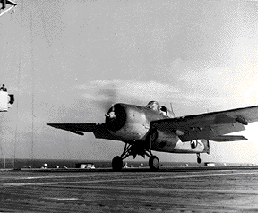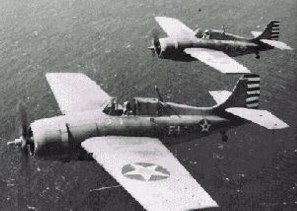Grumman F4F Wildcat
United States | Bell P-39 | Bell P-59 | Bell P-63 | Brewster F2A | P-36 Hawk | P-40 Warhawk | F4F Wildcat | F6F Hellcat | F7F Tigercat | F8F Bearcat | P-38 Lightning | Lockheed P-80 | P-51 Mustang | P-61 Black Widow | P-47 Thunderbolt | F4U Corsair
Grumman F4F Wildcat
Initially the F4F was designed as a biplane to replace the successful F3F series of biplane carrier based fighters. But as the era of the biplane fighter faded, the fighter was redesigned as a mid-wing monoplane. The US Navy however chose the Brewster F2A Buffalo as its next fighter, but Grumman continued work on the F4F and gave it a more powerful engine. In early 1939, the French navy ordered 154 of the Grumman fighters, and most of these were diverted to the British as the Martlet. Also, the US Navy ordered several hundred of the fighters with the Pratt and Whitney twin wasp radials, and thus began the long and notable career of the F4F Wildcat. Many were in operation at the time of the attack on Pearl Harbor.
The first American Wildcats lost in aerial action were not shot by Japanese, or by any other enemies, but rather by jitterish US Naval Anti-Aircraft gunners on the evening of December 7th 1941. Grumman's tubby fighter scored its first kill in American hands on 9 December 1941, in the battle for Wake Island, where a Japanese bomber was shot down. The Windcat is often thought to have been inferior to the A6M Zero, its cheif opponent in the Pacific, but actually, with a trained pilot at its controls, the F4F was a match for the nimble Zero-sen. Unlike its Japanese enemy, the F4F had heavy armor protection for the pilot, fuel tanks, and other important parts of the aircraft, and the fuel tanks were self-sealing. Therefore, the F4F could take lots of punishment while just a few shots would disable the A6M beyond fighting ability.
In the Pacific, the F4Fs were alone, being themselves the only US Naval fighter available that was partly modern. They performed well in the Battle of Coral Sea, and proved themselves worthy in the Battle of Midway, where four Japanese aircraft carriers were sunk, turning the tide of the Pacific war. Later models of the Zero, with better protection and with sturdier construction, were sent up to face the F4F. It was evident that a new fighter would have to be built, for the F4F was getting outdated. Thus was the development of the F6F Hellcat, which mastered the Zero and soon would rule the Pacific.
F4Fs operated until the very end of the war, despite the F6Fs and F4Us then in operation. The F4Fs were especially suited for operations on escort carriers because of their short takeoff distance. In the Atlantic, the British used their Martlets for convoy protection and one of then even sank a German U-boat.
Specifications for F4F-3
Type: Single Seat carrier based fighter
Powerplant: One 1,250hp Pratt & Whitney R-1820-G205A 14-cylinder Twin Wasp
Dimensions: Span 38ft; Length 28ft 9in; height 11ft 11in.
Weights: empty 4,425lbs; maximum 8,050lbs.
Performance: Max speed 338mph; initial climb 3,300ft/min; range 900 miles.
Armament: six .50-caliber machine guns, 3 in each wing
Nations: United States, France, Greece, Great Britain



The F4F Wildcat